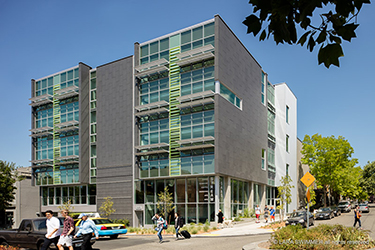|
Subscribe / Renew |
|
|
Contact Us |
|
| ► Subscribe to our Free Weekly Newsletter | |
| home | Welcome, sign in or click here to subscribe. | login |
Construction
| |
 |
August 20, 2015
Students have their say in Seattle school project
The Miller Hull Partnership

Roberts
|
The urgent need for K-12 schools to offer programs focused on science, technology, engineering and mathematics requires developing not only new curricula, but also designing the physical spaces where this advanced learning takes place.
Providing students with a foundation for success in an innovation-based economy means incorporating sophisticated elements such as labs and technically advanced facilities of a scale generally not found in primary and secondary schools. Addressing these needs in a building on a tight urban site versus a more typical sprawling school layout adds another layer of design complexity.
Our firm has designed several buildings for Seattle Academy of Arts and Sciences as it has grown, each offering a unique synthesis of the school’s education goals and its location within the vibrant, mixed-use Capitol Hill neighborhood. Attention was given to repurpose existing buildings and to step up or down in scale and character to blend with the adjacent residential and commercial neighborhoods.
The newest building — opening to students in the fall — is for a “STREAM” curriculum that combines science, technology, robotics, engineering, arts and mathematics. The five-story STREAM building includes classrooms, labs and a two-story multifunction Learning Commons that integrates a nationally competitive robotics program with visual and performing arts.
Embracing creativity
Seattle Academy is an independent school serving middle- and upper-school grades. Its educational curriculum is project-based and rooted in a “culture of performance” where risks are taken and creativity is embraced.
Beyond technical and creative academic disciplines, Seattle Academy students are also keenly engaged with their role in environmental responsibility. At the outset of the design process, we and project partners saw this firsthand.
Upper-school students in sustainability courses participated with our designers and the GLY Construction team in “visioning” workshops to establish project goals. Using the STREAM building as a case study in their coursework, they shared research and creative ideas about sustainable building practices.
It quickly became clear these young visionaries were challenging designers and administrators to deliver innovation that demonstrated environmental responsibility, as well as a place that enhances the school community.
Project goals included a high-tech and flexible environment for learning, embracing opportunities for crossover of technology and art. The Learning Commons stitches together the urban campus by physically connecting the STREAM building to the existing Arts Center and gymnasium we had designed years before.

The Learning Commons spaces can be configured to support collaboration, teaching, research, study, rehearsal and presentation, student dining and social events. Wall surfaces are an array of digital projection, art display, writable surfaces and connection to the neighborhood outdoors. Breakout spaces at the upper classroom floors inspire these activities at a smaller scale.
Adaptability and sense of connection bring creative opportunities to lab classrooms. A flexible power and data infrastructure in the robotics and innovations lab support simultaneous setup for teaching, making and competition fields.
Floors three through five are organized with two lab classrooms flanking a shared prep room. Systems-intensive uses such as fume hoods were able to be concentrated in the prep room, allowing for natural ventilation and increased daylight in lab classrooms. Visual transparency between lab classrooms and prep rooms heightens the connection between spaces.
A green design
The design team worked with school administrators to design a high-performance building, guided by principles established with the students. Features include an 11,900-gallon cistern that collects rainwater from the roof to be reused for nearly all of the building’s toilet flushing and landscape irrigation.
Energy use is reduced through daylighting, passive cooling and a high-efficiency heating system that includes a radiant floor slab and hydronic ceiling system. At upper classroom floors, the south facade brings abundant daylight, controlled by exterior sunshades and interior window coverings.
Automated and manually operable window openings promote natural ventilation through classrooms, circulation and breakout spaces. Interpretive experiences allow users to engage with the school’s environmental features.
A small green roof is visible from classrooms, and a vertically landscaped exterior wall promotes natural habitat and enhances the streetscape. Bio-retention planters with native plants control stormwater flow and provide water-quality treatment.
Rooftop photovoltaic panels installed on the STREAM and Arts Center buildings harness solar energy. Sustainable, durable, long-life materials are used throughout the STREAM building.
The project is on track to achieve a LEED gold rating.
Seattle Academy’s campus presented multiple siting challenges in terms of building scale, transportation impacts, materials and facilitating student life on the streets.
The STREAM building sits on a small lot relative to its program, so the massing needed to go vertical. To mitigate the bulk, the five-story structure was designed with two very different facades — the fully glazed facade to the south and the semi-blank facade to the east.
With this strategy, we were able to capture the best solar orientation for daylighting and natural ventilation, and buffer the single-family residences across the street to the east.
Seattle Academy became a member of the Seattle 2030 District, a high-performance building district. As designed, the STREAM building is expected to achieve an energy-use goal of 70 percent below the national median for a building of its type.
From our early days on the project, we could see the qualities of stewardship and innovation in the students we encountered. The sustainable educational elements grew from the students’ emphasis on healthy, inspiring, responsible spaces. By adding a high-performance building to its school community, Seattle Academy tangibly represents its commitment to educational innovation.
It has been tremendously rewarding to work on a project that embodies our firm’s longstanding sustainable design philosophy, and which reinforces Seattle Academy’s mission to enrich the experiences of students and teachers to bring out their fullest potential for a successful future.
Becky Roberts is a project architect with The Miller Hull Partnership.
Other Stories:
- Landmark Paul Thiry school reopens to students after 34 years
- New Vancouver high school prepares students for careers in health care
- High-tech tools help contractors keep up as school construction booms
- The grass is actually greener for schools that install synthetic turf
- A ‘third place’: where students can be themselves
- Six trends shaping the future of campus design
- Bellevue College will open its first on-campus housing in 2018
- How to make existing schools healthier, more efficient
- You can have a safe school theater — even on a budget
- How to design schools to prepare kids for careers that don’t exist yet



